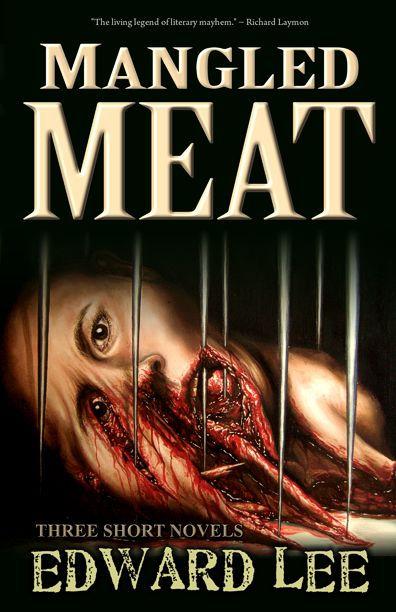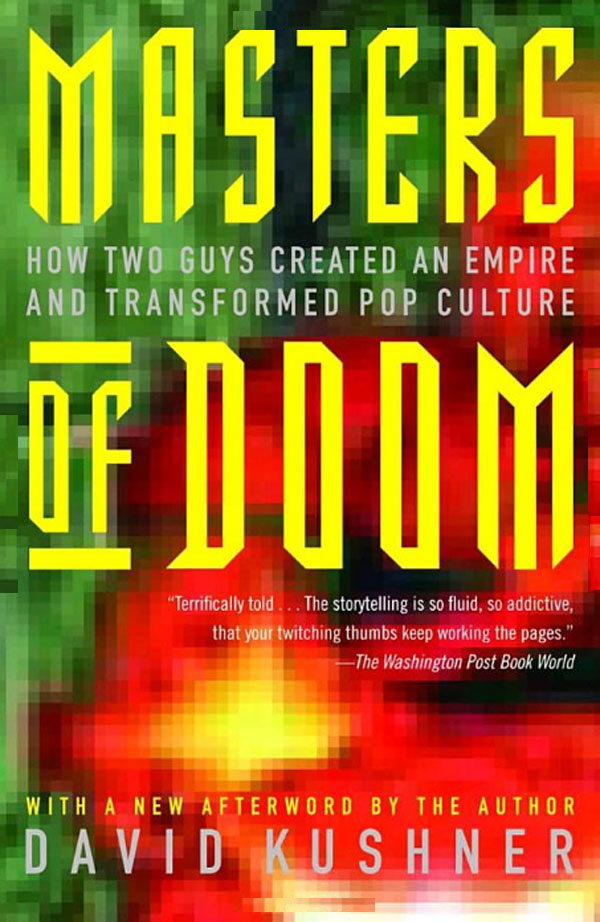 The stories are mostly good, but this is a weird product from an editing and packaging standoint.
The stories are mostly good, but this is a weird product from an editing and packaging standoint.
It has random-ass stock cover art that has nothing to with any of the stories (an almost obligatory feature of small press books), stories that don’t really make sense with each other, and a blurb on the back promising three “short novels”. Mangled Meat‘s first “novel” is 21 pages long, the second “novel” 31 pages long, and the third “novel” is 51 pages long, so yes, these are short novels. Maybe Deadite Press will publish the dot that I used to finish my last sentence and call it a “short vignette.”
“The Decortication Technician” stands out like a cockroach on a wedding cake. It has no gore or sex, but it manages to evoke a Ray Bradbury sense of wonder. In the far future, a man must dissect an alien that is like nothing he’s seen before. The writing is sometimes clunky and graceless, but it manages to create a believable futuristic world in 20 pages, and I enjoyed the big reveal at the end. To spoil it a bit, it’s like the ending of Anthony Boucher’s “The Quest for Saint Aquin” reversed. This story is good stuff.
“The Cyesolagniac” is about a guy who fancies pregnant women, and how his fetish lands him in hot water (figuratively and literally, unfortunately). Disgusting in places, and has a cute ending. I didn’t like how Lee tries to make a boring and run-of-the-mill fetish sound like the most taboo thing in the world. “Heyton sat in the chair with his pants down. A glance across the squalid room revealed his pitiful reflection in the mirror: a ludicrous caricature. The magazine shook in his hands. If my dear dead parents could see me now…” You’d think the guy liked fiddling kids or something.
“Room 415” is about a well-meaning beta male who has been cheated on, and now finds himself unable to get an erection unless he sees women being hurt. He falls in with a crooked pimp and a retinue of high-priced escorts, with nasty results. There’s some fun gore porn at the end, but I found the story to be a long car ride for a short day at the beach: long and slow, and the payoff at the end isn’t worth it. There’s lots of overly-detailed description of luscious tits and asses spilling out of translucent lingerie, etc – I get the sense that Lee was typing the story one-handed. Apparently this is the “nice” version of the story, and there’s an alternate version somewhere with a far darker and more misanthropic end.
Mangled Meat is an interesting collection. It doesn’t take more than twenty minutes to read, so it could be worthwhile if you find it cheap somewhere. The first story is the best and the last story is the worst, but they’re all at least somewhat readable. It’s not really what it was advertised as, but I could see myself reading more of Edward Lee’s short s…er, novels.
 The Greek figure Achilles and the Irish figure Cú Chulainn were fated to live a short life, filled with glory. So it is with the programmers in Masters of Doom. Nearly everyone in this book is younger than thirty, and few of them did much of note after thirty. John Carmack has left id, and doesn’t seem that fussed with FPS gaming anymore. John Romero bounces between working for game studios and trying to keep independent startups afloat. The world of gaming has passed them by, but that’s how it is for everyone. Technology is a turning wheel that leaves no spoke at the top for long.
The Greek figure Achilles and the Irish figure Cú Chulainn were fated to live a short life, filled with glory. So it is with the programmers in Masters of Doom. Nearly everyone in this book is younger than thirty, and few of them did much of note after thirty. John Carmack has left id, and doesn’t seem that fussed with FPS gaming anymore. John Romero bounces between working for game studios and trying to keep independent startups afloat. The world of gaming has passed them by, but that’s how it is for everyone. Technology is a turning wheel that leaves no spoke at the top for long.
But between 1990 and 1996, the studio called id Software revolutionalised PC gaming four times. First there was 1990’s Commander Keen, the definitive “shareware” game, and proof that PCs could handle smooth side-scrolling action games without exploding. Then there was Wolfenstein 3D, which let you fight Hitler in a crude pseudo-3D environment. Then there was 1993’s Doom, which was anything but crude: this was the first game where you didn’t need to extrapolate or use your imagination, all the gore and violence was right there on the screen in front of you. Finally there was 1996’s Quake, which had a fully 3D engine and a sophisticated multiplayer interface (which facilitated deathmatching and online clans and competitive gaming and all the rest).
This book documents their story. When I opened the book and cringed a bit at the fish-out-of-water critic blurbs (“After finishing the book, readers may come away feeling like they’ve just played a round of Doom themselves, as, squinting and light-headed, they attempt to re-enter the world.”), I had three hopes for Masters of Doom, 1) that it wouldn’t spend overly long telling us about Carmack and Romero’s childhoods, 2) that it wouldn’t get on a soapbox about school shootings, and 3) that it wouldn’t dumb anything down or misrepresent the games. All three hopes were met.
We learn about the formation of id Software, with Carmack as the technical wizard and Romero as the creative genius. We learn of the various legal and semi-legal maneuvers that got them a creative team, a payroll, and computers to work on. They come across as people so focused on their work that they didn’t have time to check whether they were compatible as friends and as people. Early in the book the Carmack/Romero team is compared to Metallica’s Hetfield/Ulrich, which is a striking comparison – those guys were a tight unit when the band was furiously gigging and recording, but they started fighting as soon as they became rich and famous. Except that’s not fair – id Software kinda were friends, at least at the beginning. We learn about a D&D game they played together.
Other developers get some spotlight, such as poor ignored Todd Hall, hardcore “gamer-grrl” Stevana Case, and an incongruous middle-aged Mormon called Sandy Petersen (who would later work on Ensemble Studio’s Age of Empires strategy games). I got to speak to Petersen on an online forum once, and I asked him why he never says much about his time with id Software. His answer was something like “Working with id was like being a hyena stripping a carcass – the job got done, but it was unpleasant. With Ensemble, I enjoyed the process as well as the result.”
The years rolled on and id Software kept laying cards on the table like a poker player with a nut hand. But infighting between Carmack and Romero took its toll, and Romero left to form a new company: Ion Storm. The sad tale of Ion Storm is also documented here, and I was expecting to skip through that part. Ion’s disastrous three years working on Daikatana is well known on the internet. But I was wrong, and learned a lot of new things, such as exactly how hostile the relationship between Ion and Eidos became after Romero blew through $44m of Eidos’s money and failed to produce a game. It makes me wonder whether Romero would ever have been successful without Carmack’s technological sorcery backing him up. Some people can only thrive in a symbiotic relationship.
For fans of Doom etc, this is a fascinating book. It shows how the games were made and how we got from there to here. Most of it seems reliable (or at least backed up by other sources I’ve read), and it’s readable and entertaining regardless of technical knowledge. It came out in 2003, but there seems to be very little in 2013 worth adding to it. Id Software had its day, and now the night comes.
 This book humbles you, and makes you realise how powerful stories can be. It’s about rabbits.
This book humbles you, and makes you realise how powerful stories can be. It’s about rabbits.
It’s been said that carnivores evolved binocular vision – both eyes pointing forward – because it’s better for hunting, while herbivores have eyes on the sides of their heads to maximise their field of vision (there are exceptions, pandas have binocular vision, for example). Combine sideways eyes with disproportionate ears and fast legs and you have a rabbit, a creature with a thousand enemies. To be a rabbit is to live in fear. Your very design is a statement of your vulnerability.
It must be stressful to be a rabbit. Constant danger. Constant alertness. Attacks might come from any quadrant and any direction – the sky, or the ground below. Your weapons are inadequate. Your only defence is vigilance. Fortunately, the fictional rabbits in this story have another defence: a precognitive runt called Fiver who one day has a vision of destruction falling on their warren.
Attempts to persuade the chief rabbit fail, and a handful of believers abandon the warren. What follows is an adventure in southern England, and then an attempt to start a new warren next to the aggressive and warlike Efrafans.
Adams makes us feel the terror and smallness of a rabbit’s existence. Human things like trains and bulldozers seem as monstrous as Greek titans. Cats seem as cruel to us as they do to the numerous small creatures in the story. There’s a scene where the heroes are helping some rabbits escape from a hutch and it feels like they’re storming Fort Knox. Reading Watership down is like watching an IMAX movie, every blade of grass magnified a hundred times on the screen.
The numerous scenes of lightness and comedy (such as the stories of the mythological rabbit El-ahrairah) are perfectly inserted into the story, and relieve the tension without breaking it. Characterisation is another strong point. Every real life rabbit has seemed boring indeed next to these ones. Nearly every real life human, too.
Some authors cheat and make their animals into humans (as in Pride of Baghdad). Other authors are conservative and leave their animals fully animal, which sounds laudable but is often boring in practice (I think Tarka the Otter was like that, but it’s been years since I’ve read it).
Richard Adams achieves a balance. The rabbits are anthropomorphalised enough so that we relate to them and understand their motives, but they are still animal enough to thrill the reader with their strangeness.
Despite their vulnerability, rabbits have proven to be astonishingly successful. A thousand enemies haven’t stopped them from devastating my country’s ecosystem. This book is equally successful, and far less harmful. It’s an amazing story that exalts the small, and makes holes dug in the ground seem like palaces.
 The stories are mostly good, but this is a weird product from an editing and packaging standoint.
The stories are mostly good, but this is a weird product from an editing and packaging standoint. 

